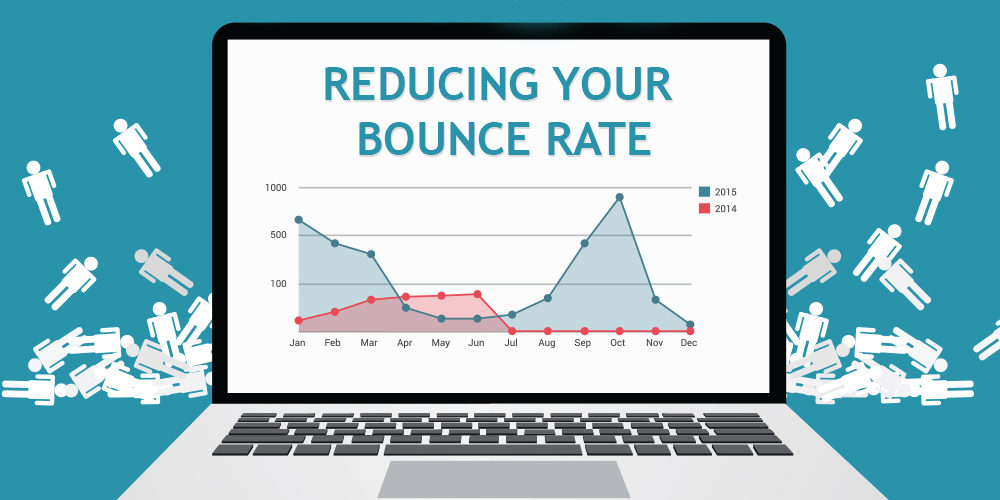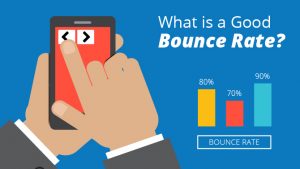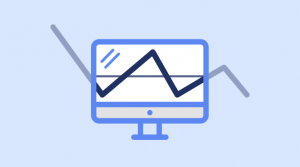12 Apr

It’s one of the most talked about metrics in digital marketing. Everyone hates bounces and everyone wants to reduce their bounce rate.
High bounce rate is one of the most common conversion killers. If the majority of your users are abandoning your website on the first page, then you don’t have a chance to convert them into subscribers or customers.
Let’s take a look at what the bounce rate is and how you can decrease it?
What is the bounce rate?
Bounce rate is defined as the percentage of visitors that leave a webpage without taking an action, such as clicking on a link, filling out a form, or making a purchase. Bounce Rate is important for three main reasons:
- Someone that bounces from your site (obviously) didn’t convert. So when you stop a visitor from bouncing, you can also increase your conversion rate.
- Bounce Rate may be used as a Google Ranking factor. In fact, one industry study found that Bounce Rate was closely correlated to first page Google rankings.
- A high Bounce Rate lets you know that your site (or specific pages on your site) has issues with content, user experience, page layout or copywriting.
High bounce rate is a good thing or bad?
A high bounce rate doesn’t always mean there’s a problem. If someone lands on your site and is looking for an address or business hours, it wouldn’t be unusual for someone to land and bounce. A visit to your business would still be considered to be a conversion.
The problem is when people land, bounce, and don’t convert. Those are the prospects we want to focus on. Your job is to find out why people are bouncing in such high numbers.
How is bounce rate calculated?
A website’s bounce rate is the percentage of people who have landed on your website and don’t browse any further. In other words, bounce rate represents single page views only.
To find this number, most people turn to Google Analytics(GA). It will give you each page’s bounce rate, which represents all single page views.
GA will also give you the average bounce rate of your entire site. This is calculated by taking the total number of bounces across all of the pages of your site (within the time period you’ve specified) divided by the number of entrances across all pages during that same period. Moreover, GA doesn’t just tell you the bounce rates of your site. Google Analytic also provides you with metrics like:
- How many visitors your site has received
- The average pages per visit
- Time on site
Why it’s important to reduce your bounce rate?
Reducing the bounce rate on pages that have the highest volume of traffic from your highest converting sources means more engaged visitors and a greater chance of conversion.
What follows is a list of considerations for reducing your bounce rate. These are by no means absolutes and are relative to everyone’s unique value propositions and audience, but generally speaking, these are worth thinking about.
1. Avoid pop-ups
Pop-up ads annoy people. In some rare cases they offer something worth the roadblock, but usually they disrupt the user experience.
2. Use intuitive navigation
Provide your visitors a clear path to the content/product they are looking for. People usually leave a website if they are not able to find what they want. Or if you are on a web page where you can’t figure out how or where to navigate, you’ll feel frustrated.
Heatmaps are a great way to gain visibility into where user’s might be trying to click, giving you insight into what should be clickable. A great tool for this is Crazy Egg.
3. Poor design
It’s not only about gradient, drop shadows etc, your content needs to be attractive; both in terms of graphical treatments and readability. Design has become a legitimacy signal and the lack thereof can directly impact visitors perceptions of the quality of your business and services.
4. Speed
Web page that takes 10 seconds or more to load really affects bounce rate. Speed negatively impacts your search rankings, and destroys your conversion rate.
5. Mobile friendly
Being mobile friendly is ideal, but being mobile usable is critical.Websites can still be effective as long as content can be accessed and used from a mobile device or tablet.
Furthermore, mobile usability does not necessarily mean from a design compatibility and accessibility standpoint, in many cases it means is the language on your site simple and clear enough that people on the go (on mobile devices) can still make sense of what they need to do to find information and at the very least contact you if necessary.
6. Design information around priorities
Websites tends to have two paths to conversion:
- landing pages (short direct sales path)
- A conversion funnel (longer process of qualifying visitors through a collection of pages that drive toward conversion)
Are you effectively managing the expectations of your visitors? A good litmus test for this is if you are able to trigger your primary page conversions more than 20 percent of the time.
7. Segment information
This is another perspective on creating content that is designed to be digested and consumed. Readability is important here but so is the idea of grouping content into segments or categories, this is most often seen in blog posts where header tags are used to break apart large walls of text.
8. Optimize for intent
This is a more detailed take on information design, and ensuring that based on the keywords your visitors are using to get to your pages, you are serving them an experience that addresses their expectations.
This is often talked about in paid search and display advertising, where the highest bounce rates are created from advertisers not closing the loop between the ad copy and the landing page copy and design. The experience needs to be consistent from start to finish or you risk breaking the user’s intent loop.
9. Ad placements
Avoid the standard ad units. Not only have web users developed ad blindness but Google has also started penalizing pages that have too many ad units above the fold, and hint: they are looking for standard ad unit sizes.
10. Lazy load third party content
Lazy loading, in case you’re unfamiliar, is a design pattern process for deferring the loading of objects until they are needed. This is done both for speed and user experience, and can be specified programmatically on a component by component basis.
11. Color contrast
Contrast between colors can make a dull story into an exciting one and conversely can turn the most exciting content in the world into a palette of indiscernible whites and grays if not given proper consideration.
Contrast is important to consider as the web moves faster towards different mediums of content, with more and more happening on the pages, it is important to use colors and patterns to draw your reader’s eyes toward the important parts of the page.
12. Messaging should be obvious
This is another consideration when it comes to focus and attention. Remember you only have a few seconds to translate value to a new visitor, so don’t make them guess.
Taglines are a great way to quickly translate a purpose, but if you don’t have one another simple way is to place your site’s purpose in plain text in an obvious place (like the header or the top of the sidebar). If you sell something, say that.
13. Cut out distraction
Many websites autoplay audio and video; these are distractions. Cutting out distractions not only leads to better bounce rates, but usually dramatically increases your conversion rates.
14. Offer related content
If you don’t offer related content on your pages, then you’re missing out on a substantial number of pageviews and the opportunity to be more of a sticky resource.
Related content gets really powerful when you’re able to target it within the same categories or tags, as these segments of content tend to be attractive to visitors who make it through related posts in the same content stack.
15. Leverage internal search
If you don’t currently offer search functionality on your website or if you don’t regularly review internal search analytics, then you’re missing the boat. Web users have become so used to search that it is an easy behavioral pattern to accommodate and leverage for improved experience. To take this a step further, you can use tools for FAQs to literally create a content roadmap for what matters most to your audience.
16. Open external links in new window
This is an incredibly simple concept that is still often overlooked, but if you’re going to link out to a resource on your website, make sure you have it open a new window instead of redirecting the user off your site.
The best and easiest way to do this is to simply add target=”_blank” into the link’s tag. So for example; anchor text.
17. Prominently display your search
Your search bar should be clearly visible and easy to go with. Make it easy for customers to search with the relevant keywords.
18. Helpful 404 page
The best thing you can do to turn a negative experience into a potentially positive one is a few things:
- Use Google’s suggestive snippet for creating useful 404 pages. Visit the “Enhance 404 pages” section in Google Webmaster Tools, which allows you to generate a JavaScript snippet.
- Add a search box and a link to the homepage
- If nothing else, add a bit of design and humor.
19. Split long posts
People have shorter attention spans than ever before. So when they see long posts they are immediately reminded of times in high school trudging through massive texts of traditional English literature. Consider instead splitting these up either into separate posts in a series or adding pagination to break up the content into smaller and more digestible chunks.
Wrap up
Bounce rate is one of those quality metrics that gets tossed around a lot in the search engine space. A high bounce rate can be indicative of a number of things but usually falls into one of two categories:
- You’re acquiring the wrong kind of traffic to your pages, or
- You’re acquiring exactly the right kind of traffic to your pages.
Bounce rate is often confused with exit rate, and the difference is important; bounce rate is a measure of people who bounced off a single page (i.e., they did not visit any other pages within your website), whereas exit rate is simply a measure of the percentage of visitors who left your site from that page.
A high bounce rate sounds the alarm that people aren’t finding what they’re looking for on your site. A healthy approach is to view this as an opportunity for improvement.


